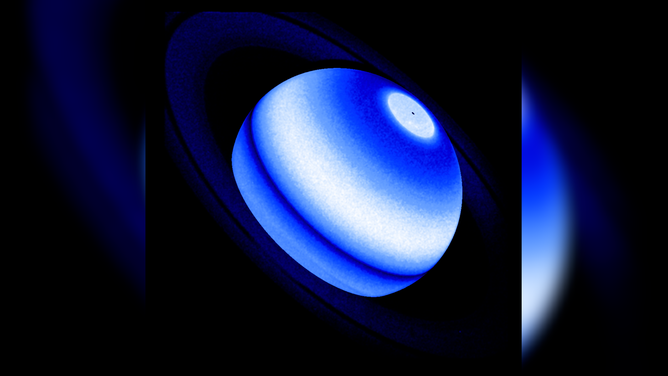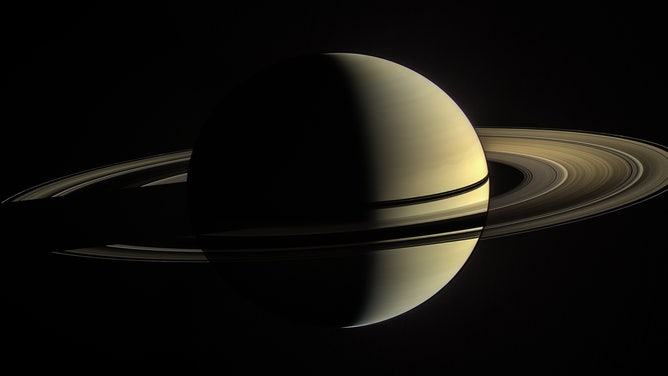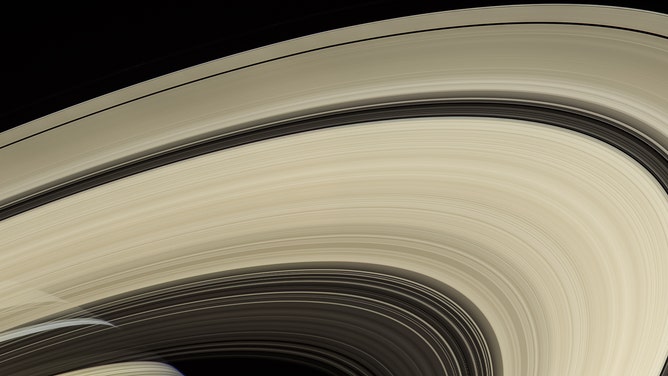NASA finds rare phenomenon happening on Saturn
The discovery was made using observations from NASA’s Hubble Space Telescope, along with the Cassini, Voyager 1 and 2 and the International Ultraviolet Explorer missions.
Watch: Four days at Saturn
NASA's Cassini spacecraft stared at Saturn for nearly 44 hours on April 25 to 27, 2016, to obtain this movie showing just over four Saturn days. (Courtesy: NASA/JPL-Caltech/Space Science Institute)
A recent study found that Saturn’s upper atmosphere is being heated by the planet’s signature rings. According to NASA, the phenomenon has never been seen before in the solar system.
In a composite image released Thursday, the strip of Saturn’s atmosphere experiencing higher temperatures appears as a bright white band at around 30 degrees latitude.
Called the Saturn Lyman-alpha bulge, this band is 30 percent brighter than the surrounding regions, NASA said.

This is a composite image showing the Saturn Lyman-alpha bulge on Saturn.
(NASA, ESA, Lotfi Ben-Jaffel (IAP & LPL) / NASA)
The Saturn Lyman-alpha bulge is caused by an excess of ultraviolet radiation, which appears as a line of hot hydrogen in the planet’s atmosphere.
According to NASA, this increased level of radiation indicates that that portion of the atmosphere is being contaminated and heating up from an outside source.
SATURN CAPTURED IN BEAUTIFUL CLARIFY BY ARIZONA PHOTOGRAPHER
The most likely source is Saturn’s rings, which rain down icy particles onto the planet. NASA said this "ice rain" from the rings might be caused by micrometeorites, solar wind particle bombardment, solar ultraviolet radiation or electromagnetic forces picking up electrically charged dust.

This was Cassini’s view from orbit around Saturn on Jan. 2, 2010. In this image, the rings on the night side of the planet have been brightened significantly to more clearly reveal their features.
(NASA/JPL-Caltech/Space Science Institute / NASA)
"Everything is driven by ring particles cascading into the atmosphere at specific latitudes. They modify the upper atmosphere, changing the composition," said Lotfi Ben-Jaffel, astronomer and author of a paper published on March 30 in the Planetary Science Journal.
"And then you also have collisional processes with atmospheric gasses that are probably heating the atmosphere at a specific altitude," Ben-Jaffel added.
Additionally, he found that the higher UV radiation in the Saturn Lyman-alpha bulge did not change throughout the ringed planet’s orbit around the sun, which takes about 29.4 Earth years, NASA said.

Saturn's rings are made mostly of particles of water ice that range in size from smaller than a grain of sand to as large as mountains. The ring system extends up to 175,000 miles (282,000 kilometers) from the planet, but for all their immense width, the rings are razor-thin, about 30 feet (10 meters) thick in most places.
(NASA/JPL-Caltech/Space Science Institute / NASA)
Ben-Jaffel analyzed four decades of UV data from the Hubble Space Telescope, along with four space missions that studied the ringed planet: the Cassini mission, which arrived at Saturn in 2004, the Voyager 1 and 2 missions from the 1980s, and the International Ultraviolet Explorer mission that was launched in 1978.
While rings can also be found around Jupiter, Uranus and Neptune, NASA said Saturn is the only planet where this phenomenon of rings heating a planet's atmosphere is occurring.
